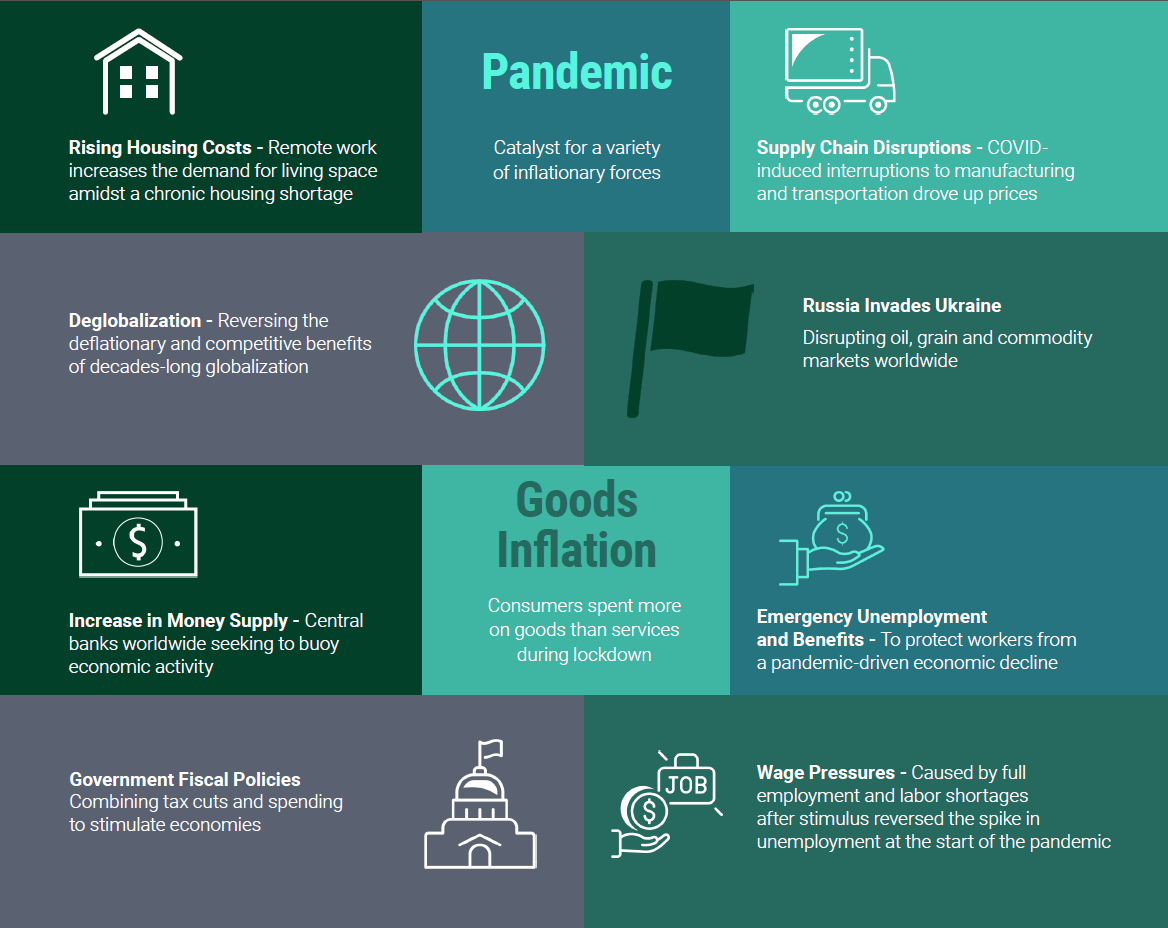10 Drivers of Persistent Inflation and 5 Inflation-Sensitive ETF Categories to Fight Them
In 2022, inflation spiked to an annualized rate of 9.2%, a 40-year high. Inflation has moderated since but remains elevated.
The pandemic set a variety of forces in motion that continue to cause inflation today. What are these forces and what actions should investors take?
Causes of Today’s Persistent Inflation
The table below provides a quick guide to the dynamics driving today’s elevated inflation. Understanding these dynamics is key to navigating the investment implications.

Action Plan for Today’s Inflation
What should investors do next? Adding inflation-sensitive investments to your portfolio can help you hedge against and even seek potential positive returns from inflation. ETFs may provide user-friendly, lower-cost and tax-efficient approaches to investing for inflation.
5 Key ETF Inflation-Sensitive Categories
- Inflation-Sensitive Equities: Equities have achieved long-term rates of return above inflation in the past, demonstrating their potential effectiveness in preserving purchasing power. Some equity sectors have been more effective as an inflation hedge than others.
- Commodity ETFs: Historically, commodity prices have risen with inflation, and different commodities exhibit varying levels of inflation sensitivity. Commodity-based ETFs provide efficient access to this asset class.
- Gold and Precious Metal ETPs: Since ancient times, gold and precious metals have been considered an enduring store of value. Exchange-traded products can offer a user-friendly way to access these assets. While gold and precious metals ETPs can be effective inflation hedges, they can be highly volatile and should be part of a diversified portfolio. Remember, diversification helps spread risk but cannot ensure a profit or protect against loss in a declining market.
- Treasury Inflation-Linked Bonds ETFs: TIPS ETFs invest in bonds whose principal and interest payments adjust with inflation, providing a hedge against rising prices.
- Multi-Asset Inflation ETFs: Some combination of the assets above are what’s needed to effectively hedge against inflation. Multi-asset inflation ETFs provide an all-in-one solution for investors seeking to hedge against inflation risk and benefit from inflation.
Take Action Against Inflation
Understanding the causes of today’s inflation comes first. Finding the right investments for inflation follows.
AXS Investments
AXS Investments is a leading alternative investment manager providing a diversified family of alternative investments for growth, income and diversification. The firm empowers investors to diversify their portfolios with investments previously available only to the largest institutional and high net worth investors. The investor-friendly AXS funds are time-tested, liquid, transparent and managed by high pedigreed portfolio managers with long and strong track records. For more information, visit www.axsinvestments.com.
This information is educational in nature and does not constitute investment advice. These views are subject to change at any time based on market and other conditions and no forecasts can be guaranteed. These views may not be relied upon as investment advice or as an indication of any investment or trading intent. This content should not be construed as an offer to sell, a solicitation of an offer to buy, or a recommendation for any security by AXS Investments or any third-party. All investing is subject to risk, including the possible loss of the money you invest.
ETFs involve risk including possible loss of principal. Diversification is a strategy designed to manage risk. It cannot ensure a profit or protect against loss in a declining market.
Equity Securities Risk: Equity securities may be particularly sensitive to rising interest rates, as the cost of capital rises and borrowing costs increase. Equity securities may decline significantly in price over short or extended periods of time, and such declines may occur in the equity market as a whole, or in only a particular country, company, industry or sector of the market.
Commodities Risk: Commodity prices can have significant volatility, and exposure to commodities can cause the value of an investment to decline or fluctuate in a rapid and unpredictable manner. The values of commodities may be affected by changes in overall market movements, real or perceived inflationary trends, commodity index volatility, changes in interest rates or currency exchange rates, population growth and changing demographics, international economic, political and regulatory developments, and factors affecting a particular region, industry or commodity. ETFs may utilize futures contracts for commodities investments. The risk of a position in a futures contract may be very large compared to the relatively low level of margin the underlying ETF is required to deposit. In many cases, a relatively small price movement in a futures contract may result in immediate and substantial loss or gain to the investor relative to the size of a required margin deposit. The prices of futures contracts may not correlate perfectly with movements in the securities or index underlying them.
Gold and Precious Metals Risks: Precious metal ETF shares trade like stocks, are subject to investment risk and will fluctuate in market value. The value of the shares relates directly to the value of the metals held by the ETF (less its expenses), and fluctuations in the price of the metal could materially and adversely affect an investment in the shares. The price received upon the sale of the shares, which trade at market price, may be more or less than the value of the metal represented by them.
TIPS Risk: Principal payments for Treasury Inflation-Protection Securities are adjusted according to changes in the Consumer Price Index (CPI). While this may provide a hedge against inflation, the returns may be relatively lower than those of other securities. Similar to other issuers, changes to the financial condition or credit rating of the U.S. government may cause the value of the Fund’s exposure to U.S. Treasury obligations to decline.
Distributed by ALPS Distributors, Inc, which is not affiliated with AXS Investments. AXI000341
© 2023, AXS Investments

Author: John Davi
Portfolio Manager, AXS Astoria Inflation Sensitive ETF (PPI) Mr. Davi is the CEO, CIO and Founder of Astoria Portfolio Advisors, a leading investment management firm and ETF Strategist, specializing in research driven, multi-asset ETF and thematic equity portfolio construction. He is an award-winning research strategist and has over 20 years of experience as an ETF industry leader and innovator.
Tags:
Stay Connected
Subscribe to our blog to keep up with the latest insights
Featured Posts
Related posts from blog
Check out our related posts based on your search that you may like
By the time inflation reemerged from a three-decade hibernation, Astoria Portfolio Advisors and CEO ...
Today we face a challenge that lay dormant for years. Inflation rose rapidly in 2021 driven by pande...
Inflation has been a top financial headline for a while due to its pervasive impact on consumers, bu...


